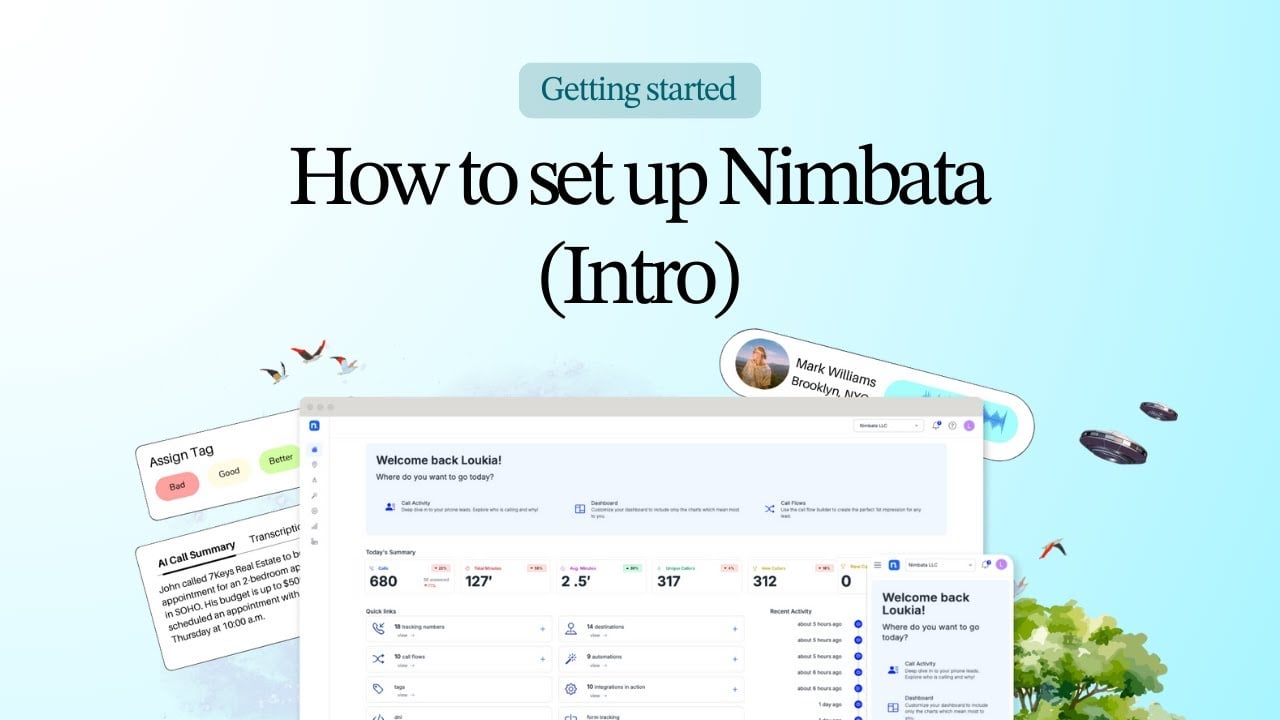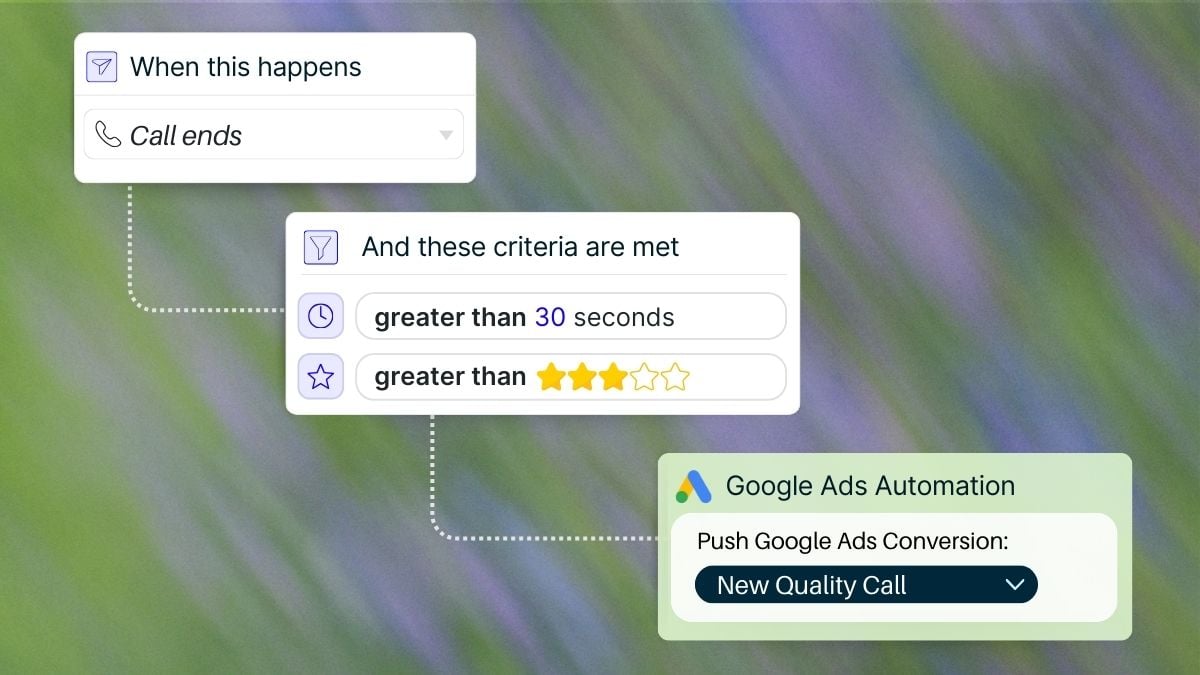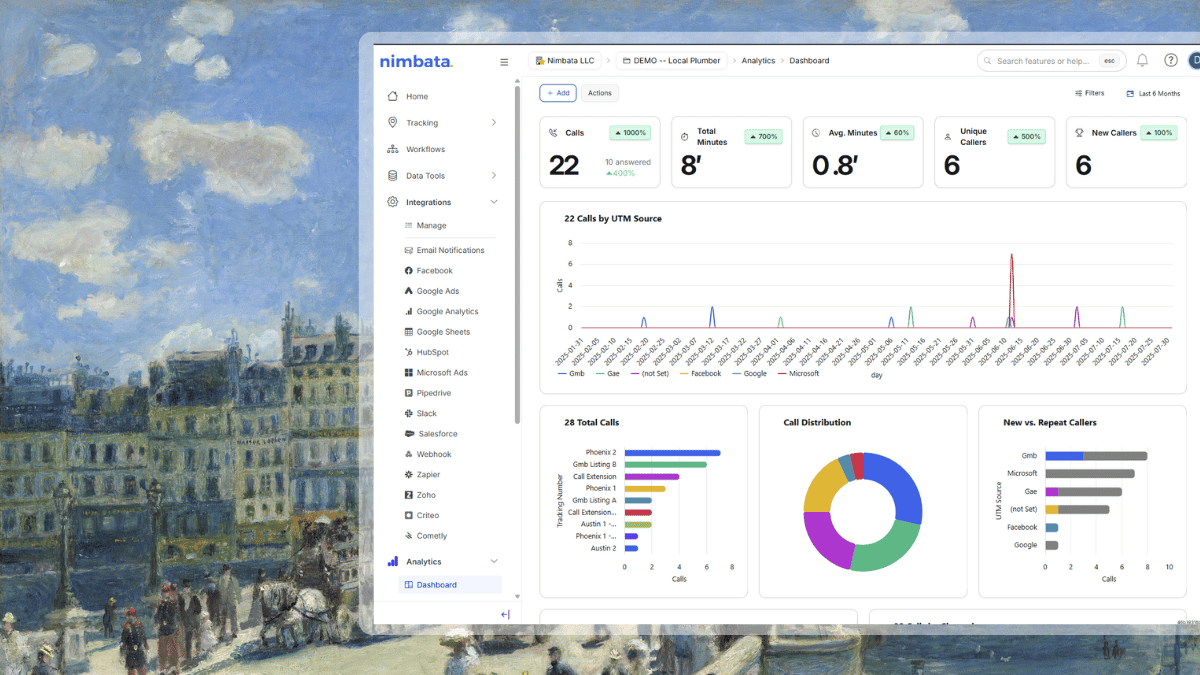Let’s face it – phone calls are where deals get real. Whether it’s a potential customer asking about your services or a lead ready to commit, these conversations hold the key to understanding how your website performs. But here’s the kicker: when you’re not tracking phone calls, it’s like you’re flying straight into the unknown, completely blindfolded.
You may know someone has called you, but do you know why they did it? Which page did they land on that led them to pick up the phone? Or, how does that interaction contribute to your bottom line? The good news is there’s no need for you to rely on your best guess anymore. Follow our guide as we break down 4 proven ways to track phone calls.
This process, called website call tracking, helps you measure and understand the effectiveness of your website in generating phone leads. Whether you’re running ads or relying on SEO, it gives you visibility into which touchpoints lead to real conversations.
Key takeaways on how to track phone calls
The following list shows you how to track phone calls from your website using four tried-and-true methods; from manual strategies to advanced automation. to track phone calls from your website:
- Better Data = Better Decisions: No matter the method you choose, start by understanding which marketing efforts drive phone calls. The better your insights, the easier you hit your goals.
- Start simple, then scale: If you’re a small business with low call volume, start with basic methods like asking callers directly or tracking click-to-call events. These are low-cost and easy to implement, though limited in insight.
- Clicking isn’t calling: Click-to-call tracking shows intent but not actual calls, especially when users dial your number manually. It’s a good first step, but it lacks accuracy and context.
- Google Ads call tracking is great, but limited: Google’s built-in call conversion tracking is a solid free tool, but it only works with Google Ads traffic. If you’re running campaigns across multiple platforms, you’ll need more comprehensive tracking.
- For full insight, use a call tracking platform like Nimbata: Advanced call tracking software like Nimbata captures the full journey – where callers came from, what they did on your site, and what was said on the call. It helps you analyze performance, classify leads, and integrate data with your marketing tools.
Bottom line? The more accurately you track phone calls from your website, the better your ability to optimize for lead quality and channel performance.Take a short glance before diving deeper.
| Method to track website calls | Free | Pros | Cons | Best for |
|---|---|---|---|---|
| Asking callers directly | YES | ✔️ Builds relationships with customers | ❌ Not scalable ❌ Might get wrong answers | Small Businesses with very low call volumes |
| Counting clicks on a particular call-to-action | YES | ✔️ Good to start tracking your first calls | ❌ Accidental clicks will count as conversions (that’s around 40% of clicks) ❌ No accurate data | Small Businesses with low-medium call volumes |
| Using Google Ads Phone Call Conversions | YES | ✔️ Tracks phone calls from all devices & manual dials | ❌ Works only for Google Ads traffic | Businesses that generate calls only for Google Ads Campaigns |
| Implementing a Call Tracking solution | NO | ✔️ Accurate call tracking for every channel gathering rich data for every caller | ❌ Paid option | Data-driven Businesses that generate medium-large call volumes and want to generate more. |
Without further ado, ere are the most effective ways to track calls from your website and understand you conversions:
Method #1 – Track phone calls by asking callers directly
In a glance
✔️ Free
✔️ Builds relationships with customers
❌ Time-consuming
❌ Not scalable
❌ Might annoy some callers
❌ Might get wrong answers
❌ Analysis needs more effort
The Effectiveness of direct questions
Asking callers directly about how they discovered your website is a straightforward and cost-effective method of tracking phone calls. This approach is highly effective, especially for businesses that receive a manageable volume of calls. When your team interacts with customers, they have the chance to ask a simple question about what prompted the call. This person-to-person approach often leads to better, extra bits of information that cannot be conveyed through an automated tracking method.
With just a few questions, you can figure out:
- Which marketing source generated this call (q: How did you find us?)
- What product/service is this call about (q: Is there something specific I can help with?)
Direct inquiries can reveal not just which marketing channel led to the call, but also the caller’s thought process and the specific aspects of your marketing that resonated with them. However, the success of this method relies heavily on consistent execution by staff and honest feedback from callers. It provides immediate feedback and can be implemented without any upfront investment in technology.
Potential drawbacks and considerations
While asking callers directly is a simple way to track phone calls from your website, there are potential drawbacks to consider. First, this method relies on human memory, which can be unreliable. Callers may not remember where or how they found your number, or they may provide a generic answer that lacks the detail needed for accurate tracking and attribution.
Inconsistency may be another issue you face with this approach, as it heavily depends on staff asking the question every single time and keeping a consistent record of the answers. When a caller is unsure of how to respond, such a question can disrupt the natural flow of the conversation, affecting their overall customer experience negatively. For businesses with high call volumes, it might become impractical to track each call manually.
While direct inquiries can provide valuable information, you should use them in tandem with other tracking methods to collect all the data you need.
Method #2 – Track phone calls by measuring click-to-call actions
In a glance
✔️ Free
✔️ Can measure at scale
❌ Will not track phone calls from another device – manual dials
❌ Accidental clicks will count as conversions (that’s around 40% of clicks)
❌ No accurate data
During 2012-2017 mobile optimization was the next big thing. It was, by many accounts, the most used marketing buzzword for those 5 years. Part of mobile optimization is empowering visitors to easily contact your business and, rightly so, click-to-call buttons became an industry standard.
Click-to-call buttons take a user to the dial screen when clicked, but do not actually initiate the call. 🤯🤯
Consumers who found your business while browsing on their smartphone are more likely to call if offered the option. And, with the correct setup, it’s possible to track these events in Google Analytics when someone clicks on your business number.
But how do these buttons work when someone is browsing on a desktop or laptop?Most of the time they don’t. Consumers prefer to manually call the number from their phone.
How to implement this method
- Step 1: Create a GTM Trigger that fires when the click url contains “Tel”
- Step 2: Create a Phone Calls Tag
- Step 3: Link the Trigger with the Tag
- Step 4: Publish it
- Step 5: Create a Phone Call Clicks as an Event-Goal in Google Analytics
Did the above leave you scratching your head?
This in-depth guide does an amazing job at describing thoroughly the implementation process.
Method #3 – Track phone calls with Google Ads Phone Calls conversions
In a glance
✔️ Free
✔️ Scalable
✔️ Tracks phone calls from all devices & manual dials
❌ Works only for Google Ads traffic
❌ Might attract spam callers
Google is to marketers what water is to humans (okay, maybe I’m exaggerating. Or am I?)
Anyway, Google Ads enables marketers to place their products in front of the right person and monitor the effectiveness of their campaigns. By effectiveness we mean 💰
Phone calls typically lead to 💰 thus they’re not an exemption – and Google offers a way to measure those conversions.
Like in the previous method, setting this up requires some level of marketing knowledge and I strongly recommend reading Google’s official documentation. The main idea is that Google introduces unique phone numbers to your Google Ads campaigns and forwards phone calls to your main phone number. In case a visitor clicks on one of your campaigns, Google’s phone number will swap the phone number on your website via GTM. (Google Tag Manager)
Limitations of Google Ads Phone Call Tracking
Despite the numerous advantages, Google Ads Phone Call Tracking is not without its limitations. Understanding these constraints can help you make an informed decision about whether it aligns with your business needs.
- Limited Scope: Google Ads Call Tracking is primarily designed to track calls derived from Google Ads campaigns. If you have diversified marketing strategies across various platforms, this method won’t capture all the data you need. It might not be an ideal solution if your business relies heavily on SEO, social media marketing, or other non-Google advertising platforms.
- Limited Data: Google Ads fails to provide detailed data that will help you optimize your campaigns. For example, it doesn’t provide information on whether those callers converted into customers or completed desired actions.
- It only offers quantitative metrics: While Google Ads Call Tracking provides quantitative metrics such as call duration, it falls short in analyzing the qualitative aspects of phone conversations. The content and quality of these calls, including whether they resulted in a positive customer experience or led to a sale, are not captured by this tracking method. Without this qualitative data, you may miss out on important insights into customer interactions.
Method #4 – Track phone calls by using a Call Tracking software
In a glance
✔️ Scalable
✔️ Tracks & attributes every single phone call
✔️ Works for all marketing channels and even offline media
✔️ Allow you to make deeper analysis to optimize better your campaigns
✔️ Integrates with your Tech stack allowing you send call conversions triggered by custom events
✔️ Richer data such as recordings, transcriptions, caller ids, who hung up, call durations, hang-up reasons and more!
❌ Paid option
If you’ve ever wondered how to track phone calls across multiple channels with full attribution, this is your go-to option.
With 3 free methods available, why choose a paid solution?
Dedicated call tracking platforms are the end-game of tracking phone calls from your website.
Call tracking tools allow for a granular level of tracking, including the caller’s journey on your website before, during, and after they make the call. They also track the call’s duration and even the caller’s geographic location. Advanced call tracking solutions may also offer call recording for quality assurance and training purposes. The data collected through the software integrates with analytics platforms and CRM systems leading to a seamless flow of information and a 360* overview of the customer’s interaction with your business. It’s a powerful tool for businesses looking to optimize their marketing strategies and improve customer engagement.
A robust website call tracking solution like Nimbata makes it easy to connect calls to campaigns, qualify leads, and optimize for what truly matters by:
- Classifying your leads, to discover which channels and campaigns brought you the most high value leads.
- Building trigger-based integrations to only send quality and sales leads to your Marketing Tools (such as Google Ads and Google Analytics 4).
- Understanding what efforts bring new callers.
- Analyzing the timeline report which includes page views, calls, and form submissions to identify common customer touchpoints.
- Building automation rules to classify your leads, assign values or any other custom property.
- Accessing the outcome of each call in seconds by reading the call summaries.
I think that I’ll pause here. The thing is that whether calls are coming from Bing, Google, Instagram, Facebook or even Offline media like Newspapers and TV, call tracking platforms will show you which places are untapped gold mines of phone calls.
You can also access our short videos to see how you can track phone calls with a call tracking tool.
Comparing different methods to track calls
Choosing the right method for tracking phone calls depends on three things: your budget, how many calls you receive, and how deep you want to go with insights.
| Method | Best For | Pros | Cons |
| Asking callers directly | Small businesses with low call volumes | ✔️ Free, builds personal rapport, easy to implement | ❌ Not scalable, prone to error, inconsistent data collection |
| Click-to-call tracking | Small to medium businesses starting with digital tracking | ✔️ Free, easy to set up, shows interest | ❌ Doesn’t track manual dials, includes accidental clicks (~40%), lacks call outcome data |
| Google Ads call conversions | Businesses focused on Google Ads traffic | ✔️ Tracks across devices, scalable, integrates with Ads data | ❌ Only tracks Google Ads calls, limited qualitative insights |
| Call tracking software | Medium to large businesses with multi-channel marketing | ✔️ Comprehensive data, works across platforms, integrates with CRM/analytics | ❌ Paid solution, requires setup time |
TL;DR:
- If you’re running ads on Google, start by enabling Google Ads Call Conversions.
- If you need to track calls from your website across multiple sources and want actionable insights (like call quality and lead value), invest in a dedicated call tracking platform.
- For simple needs, basic manual tracking or click-to-call is enough – just know the limitations.



